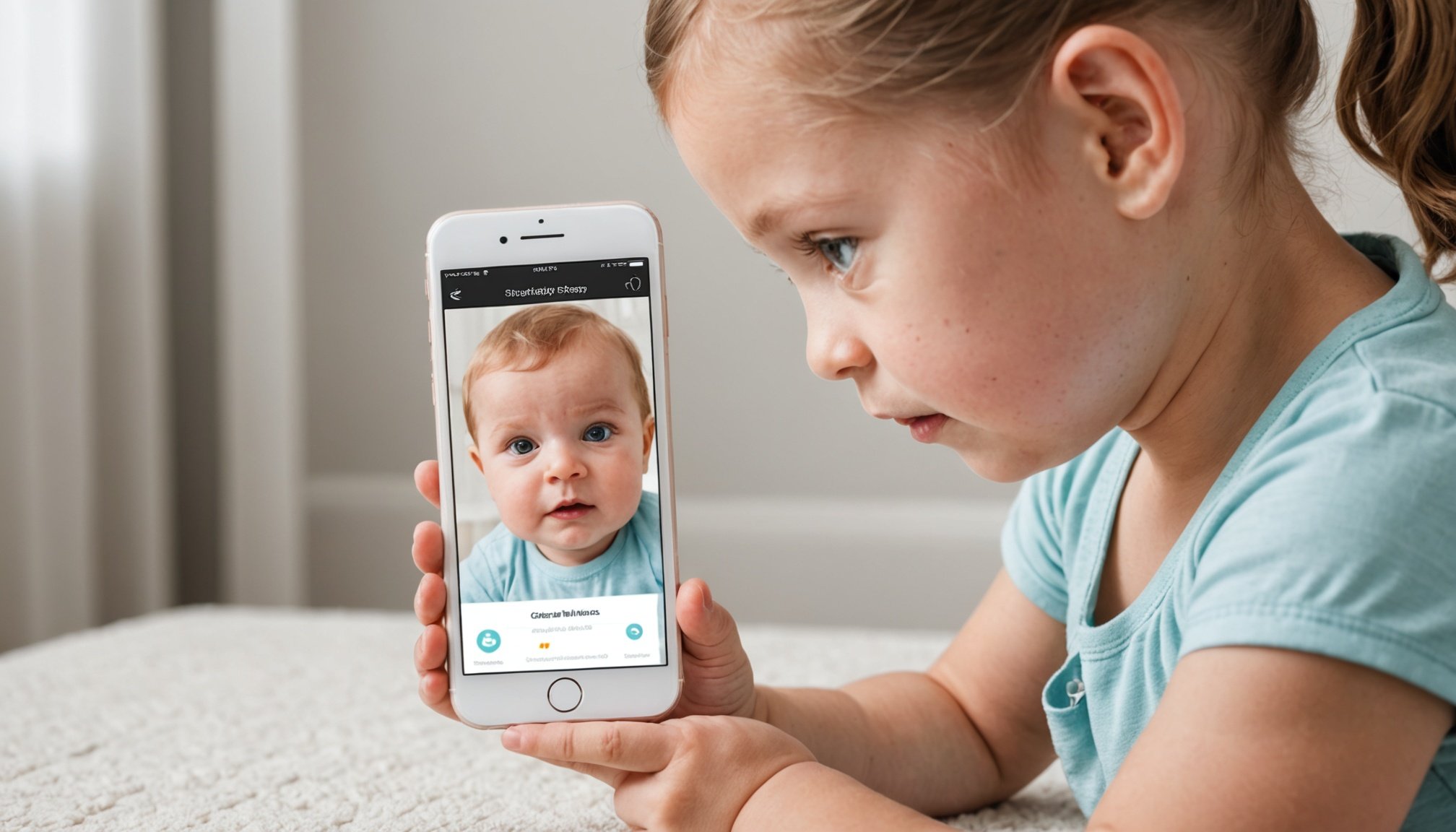Overview of Smartphone Baby Monitoring
Smartphone baby monitoring has revolutionised childcare by offering a flexible and user-friendly monitoring system. Unlike traditional setups, a smartphone baby monitor integrates directly with mobile devices, replacing bulky hardware with apps that provide real-time video and audio feeds. This smart baby monitoring system utilises the smartphone’s capabilities to keep track of the baby’s environment, offering peace of mind to parents.
Smartphone apps enhance these systems by adding functionalities such as motion detection, night vision, and cloud storage. These features significantly increase monitoring capabilities, especially when equipped with high-quality smartphone cameras. Users can control these features through intuitive interfaces, making the systems accessible even for the less tech-savvy.
Also to see : Transform Your Home Lighting: Master Real-Time Control with Your Smartphone
Trusted brands like Arlo and Nanit have pioneered this space, offering reliable and robust technologies. Their apps not only provide excellent video quality but also feature additional insights into sleeping patterns and environment conditions. These advances make mobile baby monitoring systems a preferred option for tech-conscious parents seeking convenience and efficiency in child monitoring. The adaptability and portability of smartphone-based systems continue to set them apart, offering an unparalleled combination of technology and practicality.
Necessary Equipment and Accessories
To optimise your mobile baby monitoring experience, consider essential baby monitor accessories and smartphone accessories for monitoring. A reliable setup starts with compatible accessories that enhance both convenience and performance.
Topic to read : Unlocking Remote Desktop: Essential Smartphone Strategies for Flawless Connectivity
Camera mounts are crucial for maintaining a stable and clear view of the baby’s environment. Opt for adjustable mounts to ensure flexibility in positioning, adapting to various room layouts and scenarios. Charging docks are another important accessory, providing a consistent power source to prevent interruptions in monitoring.
Selecting the right smartphone is equally vital. Models with superior camera quality and robust battery life, such as the latest iPhone or Samsung Galaxy models, are recommended for effective monitoring. These devices offer high-resolution video and longer monitoring duration without frequent charging.
Additionally, supporting gadgets like smart speakers can complement the monitoring system. Integrating a smart speaker allows hands-free control and audio feedback, providing seamless user interaction with the monitoring app.
Arming yourself with the right equipment ensures your smartphone baby monitor operates efficiently and effectively, providing peace of mind and comprehensive coverage of the baby’s environment.
Step-by-Step Tutorial to Transform Your Smartphone
Transforming your smartphone into a smart baby monitoring system is easier than you might think. Follow this simple smartphone setup guide to get started.
Preparing Your Smartphone
Firstly, ensure your smartphone is compatible. A device with a robust camera and stable internet connectivity is essential for optimal performance. Check for sufficient storage space to manage app installations and recordings.
Choosing and Installing the Right App
Select a reliable app designed for mobile baby monitoring. Consider features like video quality, alerts, and user interface. Securely install the app, granting only necessary permissions for functionality. Always download from official app stores to protect your device and data.
Positioning Your Smartphone for Optimal Viewing
Positioning is crucial for effective monitoring. Place your smartphone at a vantage point ensuring a full view of the crib. Avoid obstructions and optimise camera settings for clear visuals. Consider using adjustable stands or camera mounts for versatile angles.
By following this guide, you can efficiently set up a smartphone baby monitor, providing a comprehensive, flexible solution for child monitoring.
Recommended Apps for Baby Monitoring
When venturing into mobile baby monitoring, selecting the right app is crucial. The top baby monitor applications offer diverse features that cater to various needs. Among the best baby monitoring apps, “Nanit” and “Owlet” stand out due to their extensive functionalities. They provide real-time video feeds, sleep tracking, and environmental notifications, ensuring a comprehensive monitoring system.
User reviews highlight the pros and cons of each app. Nanit is praised for its detailed sleep insights, while Owlet’s heart rate monitoring feature is highly valued. However, some users mention occasional connectivity issues, a common hurdle in digital solutions. Navigating free versus paid options, it becomes clear that paid apps often include more robust security features, enhancing baby monitor safety.
These top baby monitor applications offer solutions that blend convenience with technology, allowing parents to tailor their monitoring setup to fit specific requirements. Each app has a unique approach, but all prioritise safety and efficiency. By evaluating these options, users can confidently choose an app that aligns with their lifestyle and ensures their child’s well-being with cutting-edge monitoring capabilities.
Safety Features for Smartphone Monitoring Systems
Ensuring baby monitor safety in mobile baby monitoring systems begins with recognising data protection challenges. Smartphone monitoring security is paramount, requiring apps to offer robust privacy features. Many apps implement end-to-end encryption to safeguard video and audio feeds, preventing unauthorized interception.
When choosing a monitoring app, look for features such as two-factor authentication. This adds an extra layer of protection, ensuring only authorised users can access the camera feeds. Regular software updates are crucial as they often patch identified security vulnerabilities, maintaining app integrity.
Set apps to alert you promptly of any suspicious login attempts or activities, enhancing smartphone monitoring security. Adjust in-app security settings to only grant necessary permissions, minimising exposure to potential risks. Additionally, only download apps from reputable stores, reducing the probability of downloading malicious software.
Being aware of these measures ensures users can maintain a safe monitoring environment for their children. Always review app reviews for any flagged security issues by other users to stay informed. Prioritising these safety strategies significantly contributes to a secure and trustworthy mobile baby monitoring setup.
Troubleshooting Common Issues
Navigating baby monitor troubleshooting can be straightforward with some practical strategies. Common connectivity issues, such as disrupted video feeds, often stem from weak Wi-Fi signals. To resolve this, position your router closer to the monitoring area or invest in a Wi-Fi extender. Ensuring your smartphone and monitoring app are both updated can also alleviate connectivity problems, as updates frequently include performance fixes.
Smartphone app issues might involve occasional crashes or slow response times. Begin by restarting the app or your device to clear minor glitches. If problems persist, consider uninstalling and reinstalling the app. This can rectify corrupted installations and improve app functionality significantly. Occasionally, app developers release bug patches, so keeping your app updated is crucial for optimal performance.
To maintain consistent monitoring, continuously check your device’s battery level and network connection. Using a backup power source or a charging dock can prevent unexpected shutdowns during crucial monitoring periods. Regularly cleaning your device’s cache might also enhance application speed and reliability. By applying these solutions, you can achieve a more stable and efficient baby monitoring experience.
User Experiences and Testimonials
Exploring smart baby monitoring testimonials reveals diverse user experiences and insights. Parents frequently praise the effectiveness and convenience of smartphone-based systems, highlighting enhanced peace of mind due to real-time monitoring. Users appreciate the ability to stay connected to their child’s environment from anywhere, a significant advantage over traditional monitors.
Case studies underscore the practical benefits of transitioning from conventional setups to smartphone monitoring systems. For instance, many families have shared how the adaptability of smartphone solutions has seamlessly aligned with their lifestyle changes, such as frequent travels. Moreover, the inclusion of features like motion detection and environmental alerts in these systems has been pivotal in ensuring a comprehensive understanding of their baby’s well-being.
Feedback often cites the reliability of apps in various environments. While some users mention occasional connectivity challenges, most find these issues temporary and manageable. Testimonials indicate that, overall, user satisfaction with app performance and reliability remains high. As evidenced by these experiences, smartphone baby monitors are not only convenient but also offer advanced features that significantly enhance the user experience.
Comparison: Smartphone Monitoring vs. Traditional Baby Monitors
The debate between smartphone vs traditional baby monitors often hinges on functionality and user experience. Traditional monitors provide basic video and audio feeds, often lacking the adaptability and feature-rich environment offered by their smartphone counterparts. In contrast, a smart baby monitor allows parents to leverage the advanced capabilities of their mobile devices, such as motion detection and real-time alerts, significantly enhancing baby monitor effectiveness.
When it comes to cost, smartphone-based setups frequently invest in accessories like mounts or charging docks but conserve on the standalone monitor expense. This can make them a cost-effective solution for tech-savvy parents. Meanwhile, traditional systems might entail higher upfront costs for hardware, sometimes with additional maintenance expenses.
Users often prefer smartphone monitors for their flexibility and portability, allowing monitoring from virtually any location. This ease of use often drives parents to shift away from traditional models, especially those who desire a seamless integration into their existing tech ecosystems. The gradual transition to smartphone-based systems has redefined efficient child monitoring, providing dynamic solutions to fit modern lifestyles.
Future Trends in Baby Monitoring Technology
The landscape of future baby monitoring technology is being shaped by unprecedented innovations. AI and machine learning are at the forefront, revolutionizing smart baby monitor developments. These technologies promise to enhance monitoring efficiency by predictive analytics, anticipating a baby’s needs based on past behaviours.
Smart baby monitor developments are exploring new user interfaces, making them more intuitive and user-friendly. Voice recognition and gesture controls are emerging trends that aim to provide seamless interaction with monitoring systems.
As technology progresses, the integration of smart baby monitoring systems with broader smart home ecosystems is becoming more prevalent. This offers parents the convenience of a unified system, controlling various functions from a single device.
Moreover, advancements in wearable technology are poised to provide deeper insights into a baby’s health metrics. Real-time tracking of vital signs will become more common, allowing parents to respond swiftly to potential health concerns. As the demand for more sophisticated monitoring solutions grows, the technology behind mobile baby monitoring is expected to remain at the forefront of innovation, offering solutions that are both practical and forward-thinking.











